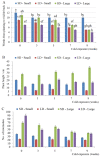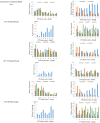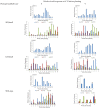Expression Patterns of Key Genes in the Photoperiod and Vernalization Flowering Pathways in Lilium longiflorum with Different Bulb Sizes
- PMID: 35955483
- PMCID: PMC9368551
- DOI: 10.3390/ijms23158341
Expression Patterns of Key Genes in the Photoperiod and Vernalization Flowering Pathways in Lilium longiflorum with Different Bulb Sizes
Abstract
Lilium longiflorum is a wild Lilium, and its flowering transition requires a long period of cold exposure to meet the demand of vernalization. The responses of different sized bulbs to cold exposure and photoperiod are different, and the floral transition pathways of small and large bulbs are different. In this study, small and large bulbs were placed in cold storage for different weeks and then cultured at a constant ambient temperature of 25 °C under long day (LD) and short day (SD) conditions. Then, the flowering characteristics and expression patterns of key genes related to the vernalization and photoperiod pathways in different groups were calculated and analyzed. The results showed that the floral transition of Lilium longiflorum was influenced by both vernalization and photoperiod, that vernalization and LD conditions can significantly improve the flowering rate of Lilium longiflorum, and that the time from planting to visible flowering buds' appearance was decreased. The flowering time and rate of large bulbs were greatly influenced by cold exposure, and the vernalization pathway acted more actively at the floral transition stage. The floral transition of small bulbs was affected more by the photoperiod pathway. Moreover, it was speculated that cold exposure may promote greater sensitivity of the small bulbs to LD conditions. In addition, the expression of LlVRN1, LlFKF1, LlGI, LlCO5, LlCO7, LlCO16, LlFT1, LlFT3 and LlSOC1 was high during the process of floral transition, and LlCO13, LlCO14 and LlCO15 were highly expressed in the vegetative stage. The expression of LlCO13 and LlCO14 was different under different lighting conditions, and the flowering induction function of LlCO9 and LlFT3 was related to vernalization. Moreover, LlFKF1, LlGI, LlCO5, LlCO16, LlSOC1 and LlFT2 were involved in the entire growth process of plants, while LlCO6, LlCO16 and LlFT1 are involved in the differentiation and formation of small bulblets of plants after the inflorescence stage, and this process is also closely related to LD conditions. This study has great significance for understanding the molecular mechanisms of the vernalization and photoperiod flowering pathways of Lilium longiflorum.
Keywords: Lilium longiflorum; bulb size; flowering related genes; photoperiod; vernalization.
Conflict of interest statement
The authors declare no conflict of interest.
Figures










Similar articles
-
Flowering pathway is regulated by bulb size in Lilium longiflorum (Easter lily).Plant Biol (Stuttg). 2016 Jul;18(4):577-84. doi: 10.1111/plb.12440. Epub 2016 Feb 23. Plant Biol (Stuttg). 2016. PMID: 26833779
-
Characterization of expressed sequence tags from Lilium longiflorum in vernalized and non-vernalized bulbs.J Plant Physiol. 2015 Jan 15;173:72-81. doi: 10.1016/j.jplph.2014.09.015. Epub 2014 Oct 17. J Plant Physiol. 2015. PMID: 25462080
-
Functional analysis and expression patterns of members of the FLOWERING LOCUS T (FT) gene family in Lilium.Plant Physiol Biochem. 2021 Jun;163:250-260. doi: 10.1016/j.plaphy.2021.03.056. Epub 2021 Apr 5. Plant Physiol Biochem. 2021. PMID: 33866146
-
Flowering responses to light and temperature.Sci China Life Sci. 2016 Apr;59(4):403-8. doi: 10.1007/s11427-015-4910-8. Epub 2015 Dec 19. Sci China Life Sci. 2016. PMID: 26687726 Review.
-
Flowering time regulation produces much fruit.Curr Opin Plant Biol. 2009 Feb;12(1):75-80. doi: 10.1016/j.pbi.2008.09.005. Epub 2008 Oct 18. Curr Opin Plant Biol. 2009. PMID: 18938104 Free PMC article. Review.
Cited by
-
Transcriptome Profiling Reveals Key Regulatory Networks for Age-Dependent Vernalization in Welsh Onion (Allium fistulosum L.).Int J Mol Sci. 2024 Dec 7;25(23):13159. doi: 10.3390/ijms252313159. Int J Mol Sci. 2024. PMID: 39684870 Free PMC article.
References
MeSH terms
Substances
Grants and funding
LinkOut - more resources
Full Text Sources
Research Materials

